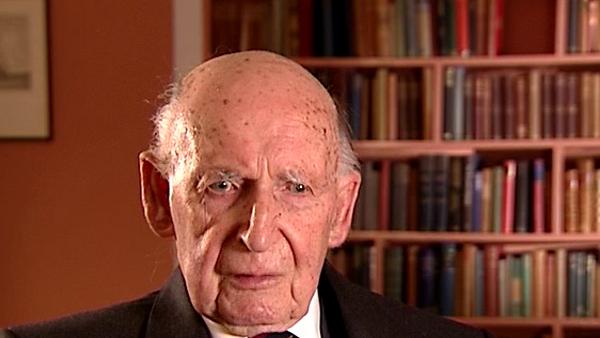NEXT STORY

A national project that gained the support of Edward Appleton
RELATED STORIES

NEXT STORY

A national project that gained the support of Edward Appleton
RELATED STORIES



What I did not then know is that Husband had been engaged in the war with the Ministry of Supply, and after the war had set up, his father was a Professor of Engineering in the University of Sheffield, and Husband had set up a consulting firm in Sheffield and that he was an expert on building bridges. In fact, when the bridge over the Menai Strait was subsequently destroyed in a fire, Husband was immediately sent for... and rebuilt that bridge, which is just now.
Anyhow, I reported this to Blackett, and Husband... we asked Husband how much he thought the project would cost, and he said, well, without a proper investigation it was difficult to say, but he thought it might be in the region of 50 or £100,000. So Blackett said, 'I think my instinct would have then have been to go to the DSIR and ask for some money', but Blackett had different ideas, he said, 'Look here, if you're going to engage in a project of this magnitude, you'll get a negative straightaway if you do that'. He said, 'You must do two things. You must get everybody in the country, who has any interest in astronomy, to back this project. And in particular you must persuade the Astronomer Royal', who was then Sir Harold Spencer-Jones, and in those days, the Astronomer Royal was a person of great astronomy... of great authority, in anything to do with astronomy.
And so I did two things. I asked the Royal Astronomical Society if they would have a special meeting, and they persuaded Martin Ryle, who was beginning his developments in radio astronomy at Cambridge, and JS Hey, who was then moving from the Army Operation Research Group to Malvern, to attend. And we were asked to explain each of our proposed developments in this new science of radio astronomy, which had in fact only just been named as radio astronomy. I think I had referred to it in an article in The Guardian, in 1948. And we... at this meeting, in Burlington House, we each put forward our plans. Now, Hey was not interested, because he had moved to another project in Malvern, and Ryle was interested in building his own interferometer in Cambridge, and so I got complete support in a minute from the Royal Astronomical Society recommending this project be explored.
Bernard Lovell (1913-2012), British radio astronomer and founder of the Jodrell Bank Observatory, received an OBE in 1946 for his work on radar, and was knighted in 1961 for his contribution to the development of radio astronomy. He obtained a PhD in 1936 at the University of Bristol. His steerable radio telescope, which tracked Sputnik across the sky, is now named the Lovell telescope.
Title: Getting support for the MK I Radio Telescope
Listeners: Megan Argo Alastair Gunn
Megan Argo is an astronomer at the University of Manchester's Jodrell Bank Observatory researching supernovae and star formation in nearby starburst galaxies. As well as research, she is involved with events in the Observatory's Visitor Centre explaining both astronomy and the history of the Observatory to the public.
Alastair Gunn is an astrophysicist at Jodrell Bank Observatory, University of Manchester. He is responsible for the coordination and execution of international radio astronomical observations at the institute and his professional research concerns the extended atmospheres of highly active binary stars. Alastair has a deep interest and knowledge of the history of radio astronomy in general and of Jodrell Bank in particular. He has written extensively about Jodrell Bank's history.
Tags: University of Sheffield, Sheffield, MK I Radio Telescope, Astronomer Royal, Royal Astronomical Society, Cambridge, Army Operation Research Group, Malvern, The Guardian, Burlington House, Menai Strait, Patrick Blackett, Harold Spencer-Jones, Martin Ryle, J S Hey
Duration: 3 minutes, 27 seconds
Date story recorded: January 2007
Date story went live: 05 September 2008